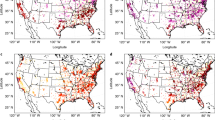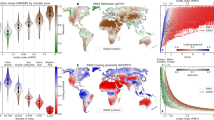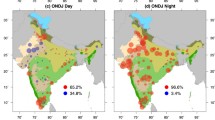Abstract
This paper examines the impacts, feedbacks, and mitigation of the urban heat island in Phoenix, Arizona (USA). At Sky Harbor Airport, urbanization has increased the nighttime minimum temperature by 5°C and the average daily temperatures by 3.1°C. Urban warming has increased the number of “misery hours per day” for humans, which may have important social consequences. Other impacts include (1) increased energy consumption for heating and cooling of buildings, (2) increased heat stress (but decreased cold stress) for plants, (3) reduced quality of cotton fiber and reduced dairy production on the urban fringe, and (4) a broadening of the seasonal thermal window for arthropods. Climate feedback loops associated with evapotranspiration, energy production and consumption associated with increased air conditioning demand, and land conversion are discussed. Urban planning and design policy could be redesigned to mitigate urban warming, and several cities in the region are incorporating concerns regarding urban warming into planning codes and practices. The issue is timely and important, because most of the world's human population growth over the next 30 years will occur in cities in warm climates.
Similar content being viewed by others
References
Akbari, H., Betz, S.E., Hanford, J.W., Kurn, D.M., Fishman, B.L., Taha, H.A. and Bos, W. (1993) Monitoring Peak Power and Cooling Energy Savings of Shade Trees and White Surfaces in the Sacramento Municipal Utility District (SMUD) Service Area: Data Analysis, Simulations, and Results. Lawrence Berkeley Laboratory Report 34411, pp. 146.
Anderson, C.A., Bushman, B.J. and Groom, R.W. (1997) Hot years and serious and deadly assault: empirical test of the heat hypothesis. J. Personality and Social Psychology 73, 1213–1223.
Anderson, C.A. (2001) Heat and violence. Current Directions in Psychological Science 10, 33–38.
Arendt, R. (1996) Conservation Design for Subdivisions: A Practical Guide to Creating Open Space Networks. Island Press, Washington, DC.
Armstrong, D.V. (1994) Heat stress interaction with shade and cooling. J. Dairy Sci. 77, 2044–2050.
Balling, R.C. and Brazel, S.W. (1987) Time and space characteristics of the Phoenix urban heat island. J. Arizona-Nevada Academy of Science 21, 75–81.
Balling, R.C. Jr. and Brazel, S.W (1988) High-resolution surface temperature patterns in a complex urban terrain. Photogrammetric Engineering & Remote Sensing 54, 1289–1293.
Balling, R.C. Jr. and Brazel, S.W. (1989) High-resolution nighttime temperature patterns in Phoenix. J. Arizona-Nevada Academy of Science 23, 49–53.
BJS (2002) Crimes reported in Maricopa County, Arizona 1998. Bureau of Justice Statistics, U.S. Bureau of Justice, Washington, DC. Available at http://www.fedstats.gov/mapstats/crime.html/crime 04013.html.
Bonan, G. (2002) Ecological Climatology Concepts and Applications. Cambridge University Press, Cambridge, UK.
Brazel, A., Selover, N., Vose, R. and Heisler, G. (2000) The tale of two climates—Baltimore and Phoenix urban LTER sites. Climate Res.15, 123–135.
Brown, P. W. (2001) Heat Stress and Cotton Yields in Arizona. Univ. of Arizona Agricultural Extension Service. Available at http://ag.arizona.edu/pubs/crops/az1224/az12242b.pdf.
Bryant, S.R., Thomas, C.D. and Bale, J.S. (2002) The influence of thermal ecology on the distribution of three nymphalid butterflies. J. Applied Ecology 39, 43–55.
Calthorpe, P. and Van der Ryn, S. (1986) Sustainable Design: A New Synthesis for Cities, Suburbs, and Towns. Sierra Club Books, San Francisco.
Changnon, S.A. (1992) Inadvertent weather modification in urban areas: lessons for Global Climate Change. Bull. Am. Meteorol. Soc. 73, 619–627.
Collins, J.P., Kinzig, A., Grimm, N.B., Fagan, W., Hope, D., Wu, J. and Borer, E.T. (2000) A new urban ecology. American Scientist 88, 416–425.
Crafts-Brandner, S.J. and Salvucci, M.E. (2000) Rubisco activase constrains the photosynthetic potential of leaves at high temperature and CO2. Proc. National Academy of Sciences, USA 97, 13430–13435.
Cushman, J.C. and Bohnert, H.J. (1997) Molecular genetics of Crassulacean acid metabolism. Plant Physiology 113, 667–676.
Emmanuel, R. (1997) Summertime urban heat island mitigation: propositions based on an investigation of intra-urban air temperature variations. Architecture Science Review 40, 155–164.
Farrar, J.F. and Williams, M.L. (1991) The effects of increased atmospheric carbon dioxide and temperature on carbon partitioning, source-sink relations and respiration. Plant Cell and Environment 14, 819–830.
Garbesi, K, Akbari, H. and Martien, P. (eds.) (1989) Controlling Summer Heat Islands, Proceedings of the Workshop on Saving Energy and Reducing Atmospheric Pollution by Controlling Summer Heat Islands, U. of California, Berkeley Energy Analysis Program, Lawrence Berkeley Laboratory, Berkeley, CA.
Gomez, F., Tamarit, N. and Jabaloyes, J. (2001) Green zones, bioclimatics studies, and human comfort in the future development of urban planning. Landscape and Urban Planning 55, 151–161.
Gratz, N.G. 1999. Emerging and resurging vector-borne diseases. Ann. Review of Entomology 44, 51–75.
Grimm, N.B., Baker, L.A. and Hope, D. (2000) An ecosystem approach to understanding cities: familiar foundations and uncharted frontiers. In Understanding Urban Ecosystems: A New Frontier for Science and Education (A.R. Berkowitz, C.H. Nilon and K.S. Hollweg, eds.), pp 94–114. Springer-Verlag, New York, NY.
Grimmond, C.S.B. and Oke, T.R. (1999) Evapotranspiration rates in urban areas. In Impacts of Urban Growth on Surface Water and Groundwater Quality, Proceedings of IUGG 99 Symposium HS5, Birmingham, July, 1999, IAHS Pub. No. 259, pp. 235–243.
Heisler, G.M., Grant, R.H., Grimmond, S. and Souch, C. (1995) Urban forests-cooling our communities? In Inside Urban Ecosystems, Proceedings of the 7th National Urban Forest Conference, New York, Sept. 12-16, 1996, pp. 31–34.
Hill, J.K., Thomas, C.D. and Huntley, B. (1999) Climate and habitat availability determine 20th century changes in a butterfly's range margin. Proc. Royal Society of London, Series B 266, 1197–1206.
Hinkley, S.A. (2000) Preparing for a Changing Climate, The Potential Consequences of Climate Variability and Change, Report of the WS Regional Assessment Group, U.S. Global Change Research Program. Institute for the Study of Planet Earth, Tuscon, AZ.
Huxman, T.E., Hamerlynck, E.P., Loik, M.E. and Smith, S.D. (1998) Gas exchange and chlorophyll fluorescence responses of three south-western Yucca species to elevated CO2 and high temperature. Plant Cell and Environment 21, 1275–1283.
Igono, M.O., Bjotvedt, G. and Sanford-Crane, H.T. (1992) Environmental profile and critical temperature effects on milk production of Holstein cows in desert climate. Int. J. Biometeorol. 36, 77–87.
Jordon, D.B. and Orgen, W.L. (1984) The CO2/O2 specificity of ribulose 1,5-bisphosphate carboxylase/oxygenase. Planta 161, 308–313.
Kabuga, J.D. (1992) The influence of thermal conditions on rectal temperature, respiration rate and pulse rate of lactating Holstein-Friesian cows. Int. J. Biometeorol. 36, 146–150.
Karl, T.R., Diaz, H.F. and Kukla, G. (1988) Urbanization: its detection and effect in the United States climate record. J. Climatology 1, 1099–1123.
Koerner, B. and Klopatek, J. (2002) Anthropogenic and natural CO2 emission sources in an arid urban environment. Environmental Pollution 116, 845–851.
Landsberg, H.E. (1970) Man-made climatic changes. Science 170, 1265–1274.
Law, R.D. and Crafts-Brandner, S.J. (1999) Inhibition and acclimation of photosynthesis to heat stress is closely correlated with activation of ribulose-1,5-bisphosphate carboxylase/oxygenase. Plant Physiology 120, 173–181.
Levitt, J. (1980) Response of Higher Plants to Environmental Stress, Vol. 1. Chilling, Freezing, and High Temperature Stresses. Academic Press, New York.
Lougeay, R, Brazel, A. and Hubble, M. (1996) Monitoring intraurban temperature patterns and associated land cover in Phoenix, Arizona using Landsat Thermal Data. Geocarto International 11, 79–90.
Martin, C.A. and Stabler, L.B. (2002) Plant gas exchange and water status in urban desert landscapes. Journal of Arid Environments, 51, 235–254.
Martin, C.A., Stutz, J.C., Kimball, B.A., Idso, S.B. and Akey, D.H. (1995) Growth and topological changes of Citrus limon (L.) Burm. f. ‘Eureka’ in response to high temperatures and elevated atmospheric carbon dioxide. J. American Society for Horticultural Science 120, 1025–1031.
Matsuura, K. (1995) Effects of climate change on building energy consumption in cities. Theor. Appl. Climatol. 51, 105–117.
McGeoch, M.A. (1998) The selection, testing and application of terrestrial insects as bioindicators. Biological Reviews of the Cambridge Philosophical Society 73, 181–201.
McIntyre, N.E. (2000) The ecology of urban arthropods: a review and call to action. Annals Entomol. Soc. Am. 93, 825–835.
McIntyre, N.E., Rango, J., Fagan, W.F. and Faeth, S.H. (2001) Ground arthropod structure in a heterogeneous urban environment. Landscape and Urban Planning 52, 257–274.
McPerson, E.G., Herrington, L.P. and Heisler, G.M. (1988) Impacts of vegetation on residential heating and cooling. Energy and Buildings 12, 41–51.
Mills, G. (1997) An urban canopy-layer climate model. Theoretical and Applied Climatology 57, 229–244.
Mills, G. (2000) Urban climatology and urban design. In Biometeorology and Urban Climatology at the Turn of the Milllennium, pp. 541–544. Selected papers from the Conference ICB-ICUC'99, World Mete. Organization, Geneva, Switzerland.
NWS (2002) Heat Wave. National Weather Service, National Oceanographics and Atmospheric Administration, Internet Weather Source. Available at http://weather.noaa.gov/weather/hwave.html#A%20National.
Oke, T.R. (1981) Canyon geometry and the nocturnal urban heat island: comparison of scale model and field observations. J. Climatology 1, 237–254.
Oke, T.R. (1997) Applied Climatology: Principles and Practice (R. D. Thompson and A. Perry, eds.). Routledge, New York.
Olszyna, K.J., Luria, M. and Meagher, J.F. (1991) The correlation of temperature and rural ozone levels in southeastern U.S.A. Atmospheric Environment 31, 3011–3022.
Pearlmutter, D. and Berliner, P. (1998) Street canyon geometry and microclimate: designing for urban comfort under arid conditions. In Environmentally Friendly Cities (E. Maldonado and S. Yannas, eds.), pp. 163–166. Proceedings of PLEA'98, Lisbon, Portugal.
Pijawka, K.D. and Shetter, K. (1995) The Environment Comes Home: Arizona Public Service Environmental Showcase Home. Hergerger Center for Design Excellence, Arizona State University Tempe, AZ.
Rokka, A., Aro, E.M., Herrmann, R.G., Andersson, B. and Vener, A.V. (2000) Dephosphorylation of photosystem II reaction center proteins in plant photosynthetic membranes as an immediate response to abrupt elevation of temperature. Plant Physiology 123, 1525–1535.
Rydin, Y. (1992) Environmental dimensions of residential development and the implications for local planning practice. J. Environmental Planning and Management 35, 43–61.
Silvertooth, J.C. and Norton, E.R. (1998) Planting Date Management. Univ. of Arizona Agricultural ExtensionService, Tuscon. Available at http://ag.arizona.edu/cotton/planting date.html.
Silvertooth, J.C. (1999) Fiber Quality Issues and Management. Univ. of Arizona Agricultural Extension Service. Available at http://ag.arizona.edu/crops/cotton/comments/nov1999cc.html.
Silvertooth, J.C. (2001) Following Cotton Development Over the Fruiting Cycle. Publication AZ 1206, Univ. ofArizona Agricultural Extension Service, Tuscon. Available at http://ag.arizona.edu/cotton/fruiting cycle.html.
Silvertooth, J.C. (2002) Crop Management Impact on Fiber Micronaire. Univ of Arizona Agricultural Extension Service, Tuscon. Available at http://ag.arizona.edu/crops/cotton/comments/mar2002cc.html.
Steiner, F. (2000) The Living Landscape: An Ecological Approach to Landscape Planning. McGraw-Hill, New York.
Stone, B. Jr. and Rogers, M.O. (2001) Urban form and thermal efficiency: how the design of cities influences the urban heat island effect. J. Am. Planning Assoc. 67, 186–198.
Thayer, R.L. Jr. (1994) Gray World, Green Heart: Technology, Nature, and the Sustainable Landscape. John Wiley and Sons, New York.
Thom, E.C. (1959) Notes on the discomfort index. Weatherwise 12, 57–60.
Thoman, M. and Bierbaum, R. (1995) Overview of adaptation to climatic change. In Adapting to Climate Change: An International Perspective (J. Smith, ed.). Springer-Verlag.
Thompson, J.W. and Sorvig, K. (2000) Sustainable Landscape Construction: A Guide to Green Building Outdoors. Island Press, Washington, DC.
Van Iersel, M.W. and Linstrom, O.M. (1999) Temperature response of whole plant CO2 exchange rates of three magnolia cultivars. J. American Society for Horticultural Science 124, 277–282.
Walker, B.H. 1991. Ecological consequences of atmospheric and climate change. Climatic Change 18, 301–316.
Whicker, A.D. (1983) Spatial and temporal distributions of tenebrionid beetles, genus Eleodes, in a grassland community. Ph.D. Dissertation, Colorado State U., Fort Collins.
Whicker, A.D. and Tracy, C.R. (1987) Tenebrionid beetles in the shortgrass prarie: daily and seasonal patterns of activity and temperature. Ecolog. Entomol. 12, 97–108.
WRI (1998) World Resources 1996-1997: The Urban Environment. World Resources Institute, United Nations Environment Programme, United Nations Development Programme, and the World Bank.
Zalom, F.G. et al. (1983) Degree-days: the calculation and use of heat units in pest management. Leaflet 21373.8, College of Natural Resources, Univ. California, Davis.
Zehnder, J.A. (2002) Simple modifications to improve fifth-generation Pennsylvania State University—National Center for Atmospheric Research mesascale model performance for the Phoenix, Arizona metropolitan area. J. Appl. Met.41, 971–979.
Author information
Authors and Affiliations
Rights and permissions
About this article
Cite this article
Baker, L.A., Brazel, A.J., Selover, N. et al. Urbanization and warming of Phoenix (Arizona, USA): Impacts, feedbacks and mitigation. Urban Ecosystems 6, 183–203 (2002). https://doi.org/10.1023/A:1026101528700
Issue Date:
DOI: https://doi.org/10.1023/A:1026101528700




